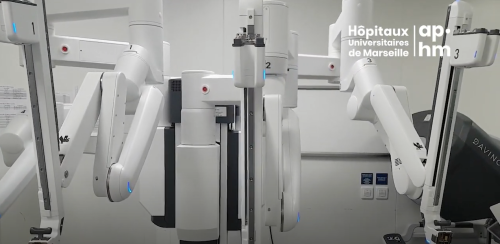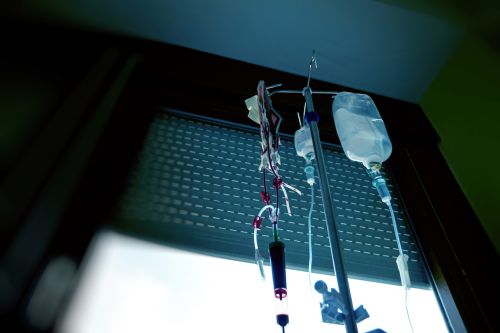Bladder cancer treatment in France
Men stepped over the barrier of the fiftieth suffer from oncological diseases of bladder cancer four times more than fair sex representatives. The distinctive features of bladder cancer are a large diversity of cell structure, origin and growth. These factors determine the rate of metastasis occurrence and the malignancy degree. Although two-thirds of malignant tumors do not grow over the boundaries of the shell, which covers this organ from the inside, they belong to a group that has a high probability of relapse. Learn everything about robotic cystectomy and bladder cancer treatment in France.
 French urologist on robotic surgery, Da Vinci robot, prostate cancer, kidney cancer, bladder cancer, cystectomy and recreating a new bladder.\n\nMedifrance Solution is your guide to the #1 healthcare system in the world 🇫🇷 \n🔵 High-quality diagnostics \u0026 treatment 🏥 \n⚪️ Wonderful travel memories 🗼🍷👠 \n🔴 Affordable prices 💰 \n\nContact us at contact@medifrancesolution.com\n\nFor more information visit http://www.medifrancesolution.com\n\nSocial:\nFacebook https://www.facebook.com/medifrancesolution/\nInstagram https://www.instagram.com/medifrance_solution\nTwitter https://twitter.com/medifrasolution\n\nSong: Christine And The Queens - Paradis perdus (Karaoké version)
French urologist on robotic surgery, Da Vinci robot, prostate cancer, kidney cancer, bladder cancer, cystectomy and recreating a new bladder.\n\nMedifrance Solution is your guide to the #1 healthcare system in the world 🇫🇷 \n🔵 High-quality diagnostics \u0026 treatment 🏥 \n⚪️ Wonderful travel memories 🗼🍷👠 \n🔴 Affordable prices 💰 \n\nContact us at contact@medifrancesolution.com\n\nFor more information visit http://www.medifrancesolution.com\n\nSocial:\nFacebook https://www.facebook.com/medifrancesolution/\nInstagram https://www.instagram.com/medifrance_solution\nTwitter https://twitter.com/medifrasolution\n\nSong: Christine And The Queens - Paradis perdus (Karaoké version)
Causes of the bladder malignant tumors occurrence
Data studies have confirmed that smokers and those who are occupied in hazardous work are subjected to tumors of this type more frequently. Individuals working with industrial dyes face the majority of the substances contributing to the development of tumors. This usually occurs at the enterprises engaged in dyeing fabrics and rubber products, producing aluminum, and in hairdressers.

The diversity of bladder cancer determines the difference in its treatment. It is impossible to choose the best option without a detailed diagnosis and evaluation of the degree of tumor extension and the type of tissue from which it is composed. As a rule, surgical treatment is prescribed in 85-90% of cases. The surgery method depends on the specific characteristics of the tumor. The complex of conservative and surgical therapy helps to prevent relapse and increase the duration of life.
The types of surgical bladder cancer treatment in France
For many years several types of operations have been developed for the treatment of malignant tumors of the bladder. In the early stages of the disease, the surgery of removing a part of the affected organ or resection is most commonly used. It can be done:
– with wide access;
– by a transurethral method.
Open resection of the bladder
Open resection refers to surgeries that are performed by an extensible approach, i.e. the surgeon comes to the injured organ through an incision in the skin and muscles. This kind of intervention is most traumatic for the patient, but in some cases, it is the only way out. For example, if a transurethral method is impossible due to the high risk to life or health of the patient.
Indications:
– a tumor located at the apex of the bladder exceeding a diameter of 4 centimeters;
– the diverticulum of the organ wall
Contraindications to surgery:
– decompensation of other diseases;
– patient’s extremely severe general condition;
– disorders of blood coagulation.
Preoperative preparation
Before open resection, a person undergoes a general survey. For this purpose, it is better to go to a hospital a few days before the operation date. Some tests and common surveys will be done in the hospital. The tests and results of diagnostic procedures will allow assessing the general state of the patient, his readiness for anesthesia and the activity of the blood coagulation system. The anesthesiologist will select the type of anesthesia, and prescribe medications for pre-preparation for anesthesia. Before the procedure, you will need to sign consent for treatment because without it surgeons do not have the right to get to work.
The progress of the operation
An incision is made on the skin in the pubic area to get access to the affected organ and through it, the doctor gets to the bladder dividing tissues and muscles. During an open resection, the surgeon removes part of the organ wall. A malignant tumor has no clear boundaries visible to the eye. Therefore, according to the rules of oncology, during the resection of a cancerous tumor, a part of undamaged tissues is taken. The resulting defect in the wall is carefully tightened with stitches. The stitching is performed using catgut.
It is a natural self-absorbable material. If the malignancy tumor has spread to adjacent organs all affected organs or their parts are removed during the operation. All tissues excised during the surgery are sent for the histology study. Histologists set the type of malignant cells that comprise the tumor and the quality of its removal once again. This study will help to determine the necessity of further chemotherapy or immune therapy. At the last stage of surgical intervention, the drainage tube is output on the anterior abdominal wall and it will be removed in a few days. The urinary catheter is set as well.
Complications of bladder open resection
Unfortunately, a number of different complications may develop after any abdominal surgery. It can be bleeding during the surgery, infections arising after resection, and many others. Whether they arise or not largely depends on how well the patient carries out the doctor’s recommendations, given to him for the recovery period of the body after the surgery.
The postoperative period
A course of antibiotics and painkillers is prescribed before and after the operation. At the same time, the decision on conducting additional courses of antitumor therapy is made. It is for the prevention of the disease relapse. A change of dressings and irrigation of the bladder with an antiseptic solution is carried out every day. The irrigations help to prevent the development of inflammation, remove blood clots from the organ cavity. After about a week, if complications are absent, the stitches and catheter are removed.

Recommendations for the postoperative period:
– it is necessary to drink a lot and often in order to irrigate the bladder naturally;
– to get out of bed and start walking after surgery as soon as possible. The best option is no later than the day after the end of the intervention;
– often and plenty of fluids to continually flush to dose physical load. After surgery, the muscles need to get stronger and the scar has to have the possibility to form entirely. Otherwise, you may receive a hernia.
Transurethral resection of the bladder
It is an endoscopic surgery that refers to minimally invasive surgery. The operation is performed with a resectoscope – a special optical instrument. A tool is inserted in the cavity of the bladder through the urethra. Transurethral surgery is the most common method of treatment used for all types of bladder tumors, including benign. This operation appears to be the “gold standard” of treatment for superficial malignant tumors in the early stages. The best results in the treatment of bladder cancer obtained by transurethral resection can be received in combination with immune or chemotherapy.
Indications:
– benign tumors;
– malignant neoplasms growing in the cavity of the organ;
– diverticula of the bladder, thrown out in the inside.
The advantages of the transurethral resection:
– complete removal of the tumor with minimal damage to the wall of an organ and surrounding tissues;
– quick recovery after the intervention;
– small number of complications, compared to open resection;
– a shorter period of hospital stay.
Contraindications to the transurethral resection:
– anatomical features of the bladder;
– the location of the tumor on the outside of the organ;
– disorders of blood coagulation;
– large size of the tumor.
Preparing for transurethral resection
The patient is hospitalized at the clinic a day or two before the surgery. During this time, he undergoes analysis and required preoperative examination. Before surgery, a discussion is held by the anesthesiologist. He ascertains a patient’s tolerance to medicines and tells about the method of anesthesia. For the prevention of infectious complications, antibiotics will be prescribed before surgery.
The progress of the operation of bladder cancer treatment in France
Transurethral resection is usually performed under spinal anesthesia. In rare cases, the anesthesiologist recommends conducting surgery under general anesthesia. When transurethral resection is carried out, an optical instrument – resectoscope – is injected into the cavity of the bladder through the urethra. Under visual control, the surgeon finds the tumor and then removes it seizing a small number of healthy tissues. The method of resection is determined by defining the size of the tumor. If it does not exceed one centimeter, the tumor along with a part of healthy tissues are removed in one motion of a special loop. When the size of the tumor is more, the excision is performed step by step. Then, the area of intervention is cauterized with a high-frequency current. This procedure does not only stop the bleeding that has occurred at the site of tissue removal, but also destroys tumor cells if any are still left. After transurethral resection is over, a urinary catheter is set.

Complications after the transurethral resection:
– perforation of the bladder wall. It occurs in about 8% of patients and is treated conservatively;
– bleeding;
– infectious complications;
– the urethra trauma or narrowing.
Like after any other surgery the complications are possible. But even their occurrence should not be the reason for the refusal from the operation, helping to defeat bladder cancer.
The postoperative period
After the transurethral resection ends, a special system that constantly cleanses the bladder from the inside with an antiseptic solution is set for several hours. It helps to remove the remains of affected tissues and clots from the cavity. Within a few weeks you can experience the urge to more frequent urination, but as the area of the operation is healed these symptoms disappear. At first, you can observe a small admixture of blood in the urine. But it is natural because there is a wound on the inner surface of the bladder that has not healed yet. The next day after the catheter is removed, the patient is discharged from the hospital.
Recommendations for the postoperative period:
– to get out of bed in the evening on the day of surgery, walk in the ward;
– to drink a lot of water and go to the toilet frequently;
– do not lift weights and to observe moderation in physical activity;
– after the discharge from the hospital to visit the doctor regularly and follow all his recommendations.
Radical cystectomy
Complete removal of the bladder or a radical cystectomy is carried out only in the following cases:
– the tumor has spread to several organ layers;
– the bladder cancer has been diagnosed at a late stage;
– the tumor is from the second to the fourth stage.
In all these cases, such extensive intervention is required in order to save a person’s life. Today, the radical cystectomy in France is carried out by the endoscopic method. Clinics involve the method of bladder removal using the Da Vinci robot.
Radical cystectomy with the help of a cyber assistant for bladder cancer treatment in France
A new method of endoscopic surgery appeared about fifteen years ago. Since that time it has won the surgeon's sympathy. In comparison with conventional laparoscopic surgery, the resection with robotics technology provides a number of advantages for doctor and patient:
– the image of the intervention area increased 10 times comes from several cameras at the same time;
– more subtle movements: when the doctor’s hand makes a movement with an amplitude of 4 mm, the robot moves the manipulator to 1 mm. This increases the precision of surgical intervention and its thoroughness;
– the robot has seven degrees of movement freedom, the laparoscope has only three;
– the operation is carried out with scalpels with the size of a few millimeters;
– the surgery period is reduced;
– the recovery period after surgery is reduced;
– tissues are not pierced but separated. The puncture is made only on the skin;
– during the operation, the nerve fibers cannot be damaged and sexual function is preserved.
The use of robotics for surgical interventions is completely safe. Robot manipulators are active only when the view of the surgeon is directed to the monitor. If the doctor turns his head to the side, the robot stops his activity. A new method of cystectomy is widely used by surgeons-oncologists in France.
Restoration of the bladder after bladder cancer treatment in France
The need for restoration of the lost organ after the operation is a serious problem. There are several methods of bladder restoration after its removal:
1. A new tank is shaped from the patient’s tissues and stitched to the urethra. It gives completely physiological sight and urination is performed in the usual way.
2. When the extensive tumors are removed and the formation of the organ is impossible, an artificial outlet is created on the abdominal wall. A special tank for collecting the urine is attached to it.
The doctors of French clinics, who use both methods, note that this restoration not only returns people to active life it also allows them to swim in the pool, play sports, and travel without difficulties.
Men and women can have all of these types of surgeries for bladder cancer. Only the doctor can decide which option will suit a particular patient. The techniques are being improved constantly. The main thing is the understanding that a malignant tumor of the bladder is not a death sentence. This is the disease, the treatment of which is successfully managed by the oncologists of French clinics.
Please contact us for further information


















